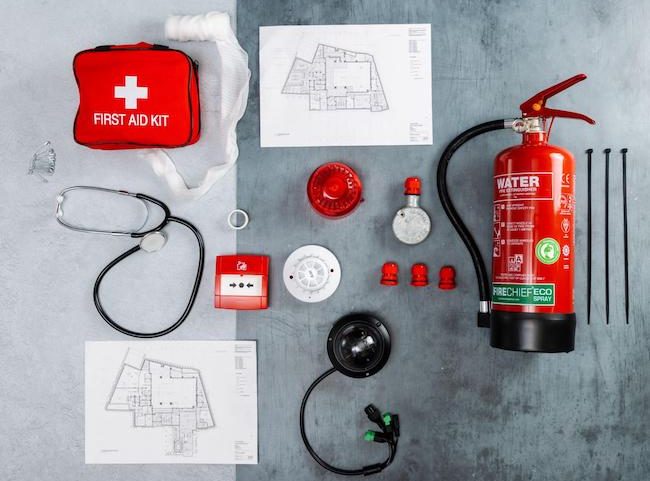The best way to be prepared for any emergency is by making sure your business can withstand the worst. A small fire could quickly turn into an all-out panic in a matter of minutes without proper precautions. It’s up to you as owners or managers to maintain safety.
With our ultimate fire safety checklist, we’ve compiled some helpful tips on what businesses should do to reduce the risk of fires. Use this guide to make sure your business is well prepared.
What Is a Fire Safety Checklist?
A fire-safety checklist is a document that helps you create a safe workplace, increase fire-safety awareness among employees and customers and maintain fire-safety standards on your business premises.
A fire-safety checklist covers many topics, including fire alarm systems, fire extinguishers and evacuation plans.

What Are the 4 Main Principles of Workplace Fire Safety?
Fire safety is an important issue for any business or organisation to consider. By following a fire-safety checklist and providing training on fire safety, businesses can minimise the risk of fire and ensure the safety of their employees. Here are the four main principles of fire safety:
1. Reduce Potential Fire Hazards
There are many potential fire hazards in any office or factory, and it’s crucial to take steps to reduce the risk of fire. A thorough fire-safety checklist should include checks like making sure all electrical equipment is up to code, ensuring fire exits are unobstructed and having a fire extinguisher in the most practical locations. Basics like fire system maintenance and servicing are essential. By taking these simple precautions, you can stop hazards from turning into emergencies.
2. Monitor Fire Prone Areas
It’s important to be proactive and monitor fire-prone areas of your business premises. This means regularly checking for potential fire hazards and taking steps to mitigate the risk. A fire-safety checklist will ensure you’re taking all the necessary precautions such as fire system testing. By monitoring and servicing the fire-prone areas of your business premises, you can help keep your employees safe and reduce the risk of a fire breaking out.
3. Check and Maintain Fire Detection and Suppression Systems
When it comes to fire safety, it’s important to ensure that your fire detection and suppression systems are up-to-date and well-maintained. This can help you detect a fire quickly and put it out before it has a chance to spread.
There are a few key things to keep in mind when maintaining your fire safety systems. First, ensure all your fire-detection systems are in good working order and properly calibrated. You should also test fire systems regularly to ensure they’re functioning properly.
Additionally, keep your fire-suppression system serviced and up to date. This way, you’ll be confident that it’s ready to go in the event of a fire.
4. Highlight and Maintain Emergency Exits
One of the most important fire-safety measures you can take is to mark and check emergency exits. This ensures that people can quickly and easily evacuate the premises in the event of a fire. Fire-safety signs should be posted near all exits and regularly checked to ensure they are unobstructed and visible. In addition, emergency exits should be well-lit and free of debris.
Your Fire Safety Checklist
You might not think about fire safety very often, but it’s important to be prepared in case of an emergency. Having a fire-safety checklist at work ensures you’re prepared if the worst happens.
Here’s our breakdown of what a fire-safety checklist should include. However, it’s important to remember that no two workplaces are the same. Your commercial premises may have unique features that require additional steps (or may mean there are steps on the checklist you can skip). It’s also worth remembering that some business sectors have specific (and more in-depth) fire-safety guidelines.
Smoke Alarms and Fire Detection
When it comes to fire safety, it’s important to ensure you have working fire detection and smoke alarm systems in place. Make sure that:
- Your system has been installed by a qualified licensed technician
- There are adequate numbers of alarms on every floor and area of the building
- The system is regularly maintained, and testing is carried out regularly to ensure it is in good working order
- You have a clear procedure in place, so everyone knows what to do if a fire breaks out.
Fire Safety Equipment
The equipment you use to keep your employees, customers and business safe from the risk of fire needs to be:
- a) The right kind of equipment
- b) Stored in the right way
- c) Checked regularly to ensure that everything is in full working order.
That means checking off the following:
- You have site-relevant and compliant fire extinguishers (or a Special Hazard Extinguishing System) installed by trained experts.
- Your fire extinguishers are all fully charged, in date and accessible to everyone.
- If you have a sprinkler system, it needs to be regularly tested and maintained.
- Test your emergency lighting so that you can confirm it works in the event of power failure.
- Check any magnetic and automatic doors are working correctly and are connected to your overall security controls.
- Your fire doors are checked to ensure they are closed and not obstructed.
- All emergency exits (including fire escape stairs/passages) are clear of obstruction and marked with fire-safety signs.
Evacuation Systems and Emergency Warning Systems
When it comes to fire safety, evacuation systems and emergency warning systems are two of the most important tools at your disposal. Evacuation systems help ensure everyone in a building can safely exit in the event of a fire, while emergency-warning systems provide critical information quickly.
A big part of your fire safety checklist means ensuring that the following are all checked regularly:
- Every member of your team has received up-to-date training on fire safety and knows all the necessary emergency procedures.
- Every employee receives training on how fire-safety equipment is to be safely used.
- Changes to your fire-safety plan are communicated to your team members.
- All fire-safety signage (including your fire door labels) is unobstructed and displayed in the right way.
- Emergency evacuation plans are on display and located where they can be easily seen and accessed.
- Evacuation routes have been provided, including routes for disabled staff and clients/customers.
- If you have manual call points (or some form of fire-marshall intercom system), this needs to be confirmed as obstruction-free and fully operational at all times.
Fire Safety Risk Assessment
It’s important to be aware of potential fire risks in your workplace, so it’s a good idea to conduct a regular fire-safety risk assessment. By doing so, you can identify any potential hazards and take steps to reduce the risk of a fire breaking out. As part of your fire safety checklist, make sure of the following:
- A member of your team (or an external expert) carries out a sufficient and thorough risk assessment regularly.
- The fire-risk assessment strategy is regularly reviewed and updated.
- A clear process is identified and followed when fire risk is identified.
Fire Drills
Do you have a fire drill plan in place? What if something happened and you had to evacuate your office quickly? By planning and having a solid evacuation procedure in place, you can help ensure your safety and that of your employees and customers.
- Hold regularly-scheduled fire drills attended by all members of your team (and include processes for evacuating customers who are not aware of your evacuation plan).
- Have a designated fire-safety warden who will plan and conduct all fire drills.
- Ensure all employees have been shown the relevant evacuation routes, as well as all fire assembly points.
- Have a system in place that makes it easy to check that nobody is left in the building.

Electrical Risks
Businesses are at risk when it comes to electrical fires. It’s important to be aware of those risks and take steps to prevent them. Electrical fires can cause serious damage, so it’s important to know what you can do to keep your business safe. A key part of your fire safety checklist will include:
- Creating a regular fire system maintenance schedule of your electrical equipment and power outlets to ensure any damage or wear and tear is spotted quickly — use a maintenance and callout service to stay more protected.
- Putting an easy process in place to ensure any broken electrical outlets or damaged power cords are replaced.
- Regular checks and testing of all power outlets to ensure they are not being overloaded.
- Machinery checks (this is often overlooked by untrained safety personnel) to ensure all machinery is free of issues that may cause overheating.
Storage Checklist
One of the most important things to remember is to keep flammable materials away from heat sources. But that’s not the only thing you need to worry about — proper storage is also key. Ensure you consistently check the following:
- All flammable and combustible materials in your workplace are not stored in the same location as electrical equipment.
- Chemical and flammable liquids are stored in ventilated and locked areas, free of spillages and minor leaks.
- A process is in place for the disposal of empty containers.
- Outside spaces are checked to ensure they are tidy, clean and cleared of discarded waste or general rubbish.
Kitchen Safety
Around two-thirds of fires in the home start in the kitchen. It’s a high-risk space in your home, and the same is true of your workspace. So if you have any kitchen facilities on your business premises, always include a dedicated section on your fire-safety checklist to ensure it’s not overlooked. It should include:
- Regular checks and maintenance on any ventilation systems
- All cooking equipment is checked for general wear and tear or signs of obvious faults
- A dry fire extinguisher is installed in kitchen areas and regularly checked and maintained
- Staff training sessions on how to safely use cooking equipment.
Extra Fire Safety Checklist Items
All of the above sections on your fire-safety checklist are vital to include. However, for some businesses, additional points need to be added to that checklist. These include:
- For businesses that have a dedicated smoking area, there needs to be regularly checked “No Smoking” signs throughout the rest of the premises, along with a strict smoke-free policy in areas that are not designated smoking spaces.
- Having security measures in place that will help prevent an arson threat.
- Lastly, ensuring you have followed any specific industry guidelines regarding fire safety. Add those requirements to your fire-safety checklist to ensure they are not forgotten.
Start your Fire Safety Checklist Now
Businesses need to be proactive in creating a fire-safety plan and ensuring employees are properly trained. A fire can cause extensive damage and disrupt business operations, so it is important to take the necessary steps to protect your company.
If you’re not sure where to start, we can help. Our team of experts can survey your property and identify any potential vulnerabilities. We also offer training programs for employees, so they know how to react in the event of a fire. Contact us today to learn more about our services or get your FREE site survey. Don’t leave your business vulnerable to the threat of fire.


